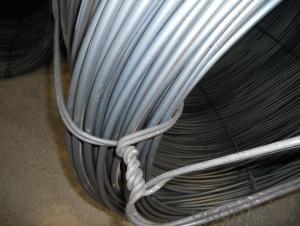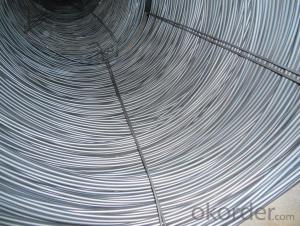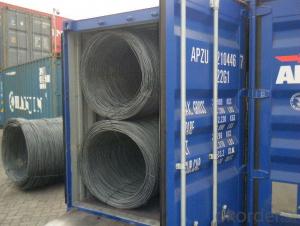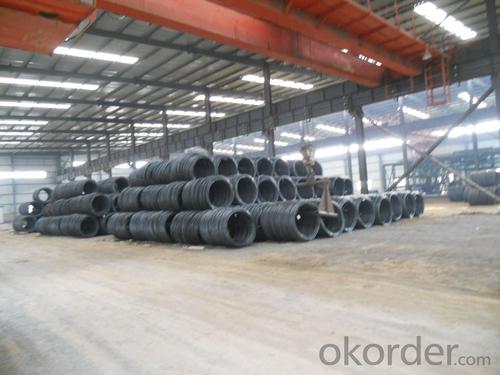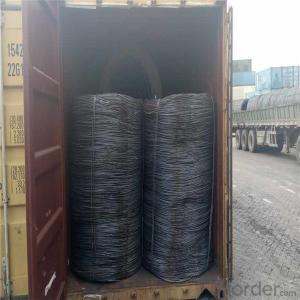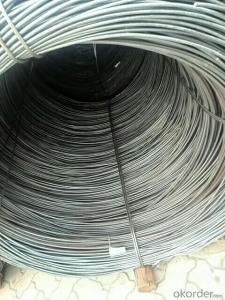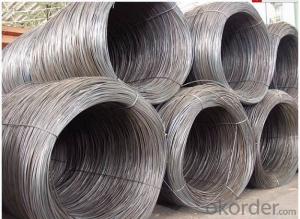Stainless Wire Rod SAE1006B of Standard ASTM
- Loading Port:
- Tianjin
- Payment Terms:
- TT OR LC
- Min Order Qty:
- 100 m.t.
- Supply Capability:
- 2000 m.t./month
OKorder Service Pledge
OKorder Financial Service
You Might Also Like
Product Description:
OKorder is offering Stainless Wire Rod SAE1006B of Standard ASTM at great prices with worldwide shipping. Our supplier is a world-class manufacturer of steel, with our products utilized the world over. OKorder annually supplies products to European, North American and Asian markets. We provide quotations within 24 hours of receiving an inquiry and guarantee competitive prices.
Product Applications:
Stainless Wire Rod SAE1006B of Standard ASTM for structural applications and are widely used in the construction of buildings and bridges, and the manufacturing, petrochemical, and transportation industries.
Product Advantages:
OKorder's Stainless Wire Rod SAE1006B of Standard ASTM are durable, strong, and resist corrosion.
Main Product Features:
· Premium quality
· Prompt delivery & seaworthy packing (30 days after receiving deposit)
· Corrosion resistance
· Can be recycled and reused
· Mill test certification
· Professional Service
· Competitive pricing
Specifications of Stainless Wire Rod SAE1006B:
Steel Grade: SAE1006B Standard: ASTM
Diameter: 5.5mm, 6.5mm, 7mm,8mm,9mm,10mm,12mm,14mm
Diameter Tolerance: +/-0.3mm
Package: as customer required
Type: in Coil, each coil weight around 2MT Coil Diameter: about 1.2M Coil Length: 1.6-1.7M
Brand Name: N-RIVER Technique: Hot Rolled
Place of Origin: Hebei, China Mainland
Chemical Composition:
Please kindly find our chemistry of our material based on SAE1006B as below for your information
Grade | Chemical Composition (%) | |||||
C | Mn | S | P | Si | B | |
SAE1006B | 0.03~O.07 | 0.32max | 0.045max | 0.040max | 0.30max | 0.0008min |
Mechanical properties | ||||||
Yield strength(N/mm2) | Tensile strength(N/mm2) | Elongation (%) | ||||
250-280 | 350-380 | ≥32 | ||||
Usage and Applications of Stainless Wire Rod SAE1006B:
After hot-rolled the products shaped into coil and delivery as finished product, including round, square, rectangular, hexagonal and so on. Since most of the products are round, it is generally called wire rod. Carbon steel wire rod is widely used in construction and manufacturing. Carbon steel wire rod is mainly used for reinforcement of reinforced concrete and welded structure or reprocessed (roberts , nail, etc.) materials, especially used to produce wire drawing, welding electrode, nails, spring, electronic, precise machinery parts and so on.
Packaging & Delivery of Wire Rod SAE1006B:
Packaging Detail: products are packed in coil and then shipped by container or bulk vessel
Each coil weight: 2-3MT
Delivery Time: within 45 days after received advanced payment or LC.
Label: to be specified by customer, generally, each bundle has 1-2 labels
Trade terms: FOB, CFR, CIF
Note:
1. Our products are produced according to national standard (GB), if not, supply according to national standards (GB) or agreement as customer required.
2. Other Grade and Standard carbon steel wire rod we can supply:
Grade: H08A, 30MnSi, 62B-82B
Standard: AISI, BS, JIS, DIN
The Minimum Order Quantity of these products is high, and need to be confirmed.
3. We can not only supply carbon steel wire rod; if you need anything about building materials, please contact us.
4. Please send us your detail specifications when inquire. We will reply to you as soon as possible. We sincerely hope we can establish a long stable business relationship.
FAQ:
Q1: Why buy Materials & Equipment from OKorder.com?
A1: All products offered byOKorder.com are carefully selected from China's most reliable manufacturing enterprises. Through its ISO certifications, OKorder.com adheres to the highest standards and a commitment to supply chain safety and customer satisfaction.
Q2: How do we guarantee the quality of our products?
A2: We have established an advanced quality management system which conducts strict quality tests at every step, from raw materials to the final product. At the same time, we provide extensive follow-up service assurances as required.
Q3: How soon can we receive the product after purchase?
A3: Within three days of placing an order, we will begin production. The specific shipping date is dependent upon international and government factors, but is typically 7 to 10 workdays.
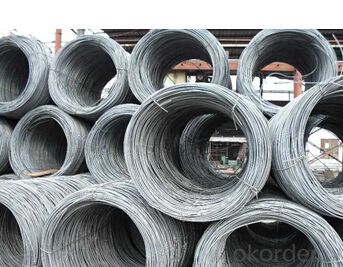
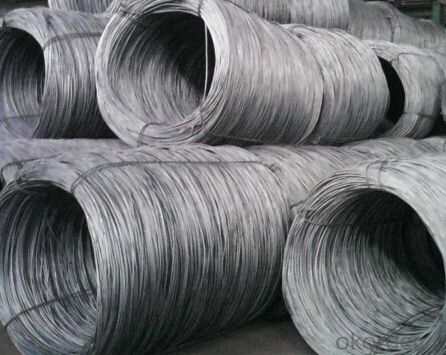
- Q: What are the major innovations in steel wire rod production technology?
- There have been several major innovations in steel wire rod production technology in recent years. These advancements have greatly improved the efficiency, quality, and sustainability of the production process. One major innovation is the implementation of continuous casting technology. Traditionally, steel wire rods were produced through a batch process, where molten steel was poured into individual molds and allowed to solidify before being cut into rods. Continuous casting, on the other hand, allows for a continuous flow of molten steel to be solidified into long strands. This not only eliminates the need for individual molds but also increases the speed and productivity of the production process. Another significant innovation is the use of high-speed rolling mills. These mills are equipped with advanced technologies that allow for faster rolling speeds and higher production rates. The use of high-speed rolling mills not only increases the output of steel wire rods but also improves the quality and consistency of the final product. Furthermore, the development of automation and digital technologies has revolutionized steel wire rod production. Automated systems and robotics are now being used to control various stages of the production process, from the handling of raw materials to the packaging of finished products. This not only reduces the risk of human error but also enhances overall efficiency and productivity. Additionally, there have been advancements in the field of metallurgy, leading to the production of stronger and more durable steel wire rods. Through the use of advanced alloys and heat treatment processes, manufacturers can now produce rods with superior mechanical properties, such as higher tensile strength and improved resistance to corrosion and fatigue. Lastly, there has been a growing focus on sustainability in steel wire rod production. Innovations in energy-efficient technologies and waste reduction strategies have led to significant improvements in the environmental impact of the industry. For example, the implementation of energy recovery systems and the use of recycled materials in the production process have helped reduce energy consumption and minimize waste generation. In conclusion, the major innovations in steel wire rod production technology include the implementation of continuous casting, the use of high-speed rolling mills, the integration of automation and digital technologies, advancements in metallurgy, and a growing emphasis on sustainability. These innovations have not only improved the efficiency and quality of steel wire rod production but have also contributed to a more sustainable and environmentally friendly industry.
- Q: How are defects in processed steel wire rod detected and corrected?
- Defects in processed steel wire rod are commonly detected using non-destructive testing methods such as visual inspection, ultrasonic testing, magnetic particle inspection, or eddy current testing. Once defects are identified, they can be corrected through various methods like grinding, welding, or heat treatment, depending on the nature and severity of the defect.
- Q: How are steel wire rods used in the production of tire cords?
- The use of steel wire rods is common in tire cord production due to their crucial role in providing strength and durability. Tire cords serve as reinforcement material within the tire's rubber, enhancing its structural integrity and resistance to wear and tear. To manufacture tire cords, steel wire rods undergo a series of processes. Initially, the rods are drawn through a die to decrease their diameter and increase their length. This wire drawing process improves the steel wires' tensile strength and flexibility. Following wire drawing, the steel wire rods undergo further processing through various heat treatment methods. These methods, such as annealing, quenching, and tempering, enhance the mechanical properties of the wire. These treatments significantly improve the wire's strength, elasticity, and resistance to fatigue, making them suitable for the demanding conditions tires experience. Once the steel wire rods have undergone proper treatment, they are then twisted or braided together to form the tire cords. These cords are typically arranged in a crisscross pattern, known as the bias angle, to provide optimal strength and stability to the tire. During the tire manufacturing process, the cords are embedded within the rubber layers. The presence of steel wire cords in tires ensures their ability to withstand the forces exerted during vehicle operation, including cornering, acceleration, and braking. These cords help distribute the load evenly across the tire, improving its handling, stability, and overall performance. Additionally, steel cords contribute to the tires' puncture resistance and longevity, making them more reliable and durable. In conclusion, steel wire rods are crucial in tire cord production, providing strength, durability, and resilience to tires. Through processes such as wire drawing, heat treatment, and twisting or braiding, steel wire rods are transformed into tire cords that enhance the structural integrity and performance of tires in various driving conditions.
- Q: What are the common industry competencies for steel wire rod manufacturers?
- Some common industry competencies for steel wire rod manufacturers include expertise in metallurgy and materials science, knowledge of production processes and equipment, understanding of quality control and testing methods, proficiency in supply chain management, and the ability to meet customer specifications and standards. Additionally, manufacturers may also need to possess strong problem-solving skills, continuous improvement strategies, and a commitment to safety and environmental regulations.
- Q: What are the main factors influencing the choice of steel wire rod order payment refund options?
- The choice of payment refund options for steel wire rod orders can be influenced by a variety of factors. However, there are several common factors that play a significant role in this decision-making process, including: 1. Supplier Reputation: A crucial factor is the reputation and trustworthiness of the supplier. Buyers often choose payment refund options that provide a sense of security in case of any issues or disputes with the supplier. 2. Order Volume and Value: The size and value of the steel wire rod order can impact the choice of payment refund options. Larger orders with higher values may require more secure refund options to mitigate potential financial risks. 3. Payment Terms and Conditions: The payment terms and conditions set by the supplier can also influence the choice of refund options. Some suppliers may offer specific refund options based on their preferred payment methods, such as bank transfers, letters of credit, or escrow services. 4. Buyer's Financial Capability: The financial capability of the buyer can also determine the choice of refund options. Buyers with limited financial resources may opt for payment refund options that offer flexibility and minimize risks, such as installment payments or delayed payment terms. 5. Delivery and Quality Assurance: The reliability and quality assurance provided by the supplier can impact the choice of refund options. Buyers may prefer refund options that allow them to inspect the steel wire rod upon delivery and ensure compliance with the agreed specifications before making full payment. 6. Market Conditions and Competition: Market conditions and competition among suppliers can influence the choice of refund options. Buyers may consider refund options that are more favorable or competitive in the market, such as cash discounts or rebates. 7. Legal and Regulatory Considerations: Legal and regulatory requirements in the buyer's jurisdiction can also affect the choice of refund options. Buyers may opt for refund options that comply with local regulations and provide legal protection in case of any disputes or non-compliance. Buyers should carefully evaluate these factors and assess their specific needs and preferences before deciding on the most suitable payment refund options for their steel wire rod orders.
- Q: How is steel wire rod used in the production of wire shelves and racks?
- Wire shelves and racks rely on steel wire rod as a vital component for their production. This material serves as the primary building block for constructing these storage solutions. To begin, the steel wire rod undergoes processing and drawing to attain the desired shape and size for the shelves and racks. This involves passing the rod through a series of dies and rollers, transforming it into a thinner and more pliable wire form. Once drawn, the wire is then bent, cut, and welded to create the essential elements of the shelves and racks. The wire rods are shaped into grids, frames, and supports, forming the fundamental structure of these storage units. The wire rods also play a crucial role in crafting the mesh or grid patterns that make up the shelving surfaces. These grids allow for the safe storage of various items, preventing them from falling through gaps. Moreover, the steel wire rod provides the necessary strength and durability to the shelves and racks. Its high tensile strength ensures that the shelves can withstand heavy loads without bending or breaking, making them suitable for industrial use where robust storage is required. Furthermore, the steel wire rod is often coated or galvanized to enhance its resistance to corrosion. This protective coating safeguards the shelves and racks from rust and other forms of deterioration, extending their lifespan and preserving their appearance. In conclusion, the utilization of steel wire rod in the production of wire shelves and racks is indispensable. It offers the essential strength, durability, and functionality required for effective storage solutions in a variety of settings, including homes, offices, warehouses, and retail spaces.
- Q: How is steel wire rod used in the production of suspension springs for marine vessels?
- Steel wire rod is commonly used in the production of suspension springs for marine vessels due to its high strength and durability. It is typically formed into coils or helical shapes to create the springs, which provide support and absorb shocks and vibrations on the vessel. The steel wire rod's superior tensile strength allows the suspension springs to withstand heavy loads and harsh marine environments, ensuring the stability and safety of the vessel.
- Q: What are the different packaging materials used for steel wire rod?
- The different packaging materials used for steel wire rod include wooden pallets, steel frames, steel strapping, and plastic wrapping.
- Q: How is steel wire rod used in the manufacturing of wire for automotive fuel injection systems?
- Steel wire rod is an essential component in the manufacturing of wire for automotive fuel injection systems. This high-quality steel wire is used to create the various wires and cables required for these systems. One of the primary uses of steel wire rod in the manufacturing process is for the production of fuel injector wiring harnesses. These harnesses are responsible for connecting the fuel injectors to the vehicle's electronic control unit (ECU). The steel wire rod is drawn into thin and precise wires that are then braided or twisted together to form the necessary harnesses. The steel wire rod used in this process is chosen for its exceptional strength, durability, and electrical conductivity. It must be able to withstand the harsh conditions under the hood of a vehicle, including high temperatures, vibrations, and exposure to chemicals. Additionally, steel wire rod is also used in the manufacturing of other wires and cables within the fuel injection system. These include sensor cables, which transmit data from various sensors to the ECU, and power cables, which provide electrical power to the fuel injectors. Overall, steel wire rod plays a crucial role in the manufacturing of wire for automotive fuel injection systems. Its strength, durability, and electrical conductivity ensure the proper functioning and longevity of these systems, ultimately contributing to the performance and efficiency of the vehicle.
- Q: How is steel wire rod used in the manufacturing of wire forms for display racks?
- The manufacturing of wire forms for display racks heavily relies on steel wire rod. This component plays a vital role as the raw material that is subjected to a range of manufacturing processes in order to create wire forms with precise shapes and sizes. The initial step involves carefully selecting the appropriate quality and diameter of steel wire rod. This selection process is dependent on the desired strength, durability, and flexibility of the wire forms. Once the suitable steel wire rod has been chosen, it is fed into a wire drawing machine. In this machine, the steel wire rod is pulled through a series of dies, effectively reducing its diameter and increasing its length. Once the wire has been successfully drawn to the desired size, it proceeds to undergo a series of shaping and bending processes. These processes may entail the utilization of specialized machines or tools to bend the wire into specific angles, curves, or shapes that are required for the display racks. Additionally, the wire may also be cut into specific lengths as per the design requirements. In order to retain the desired shape and structure of the wire forms, further processes such as heat treatment or galvanization may be carried out. Heat treatment serves to strengthen the wire forms, making them more resistant to bending or deforming when subjected to heavy loads. On the other hand, galvanization entails applying a protective layer of zinc onto the wire forms to safeguard against corrosion, thereby enhancing their lifespan. Once the wire forms have been shaped, bent, and treated, they are now ready to be assembled into the display racks. These wire forms can be employed for various purposes within the display rack industry, such as forming shelves, hooks, or frames. The versatility of steel wire rod allows for the production of wire forms in different designs, sizes, and load capacities, thus enabling them to meet the specific requirements of display rack applications. To summarize, the manufacturing process of wire forms for display racks heavily relies on steel wire rod. This crucial component undergoes a range of processes including wire drawing, shaping, bending, and treatment to produce wire forms with specific shapes, sizes, strength, and durability. Once assembled into display racks, these wire forms provide a robust and adaptable solution for showcasing products.
Send your message to us
Stainless Wire Rod SAE1006B of Standard ASTM
- Loading Port:
- Tianjin
- Payment Terms:
- TT OR LC
- Min Order Qty:
- 100 m.t.
- Supply Capability:
- 2000 m.t./month
OKorder Service Pledge
OKorder Financial Service
Similar products
Hot products
Hot Searches
Related keywords


